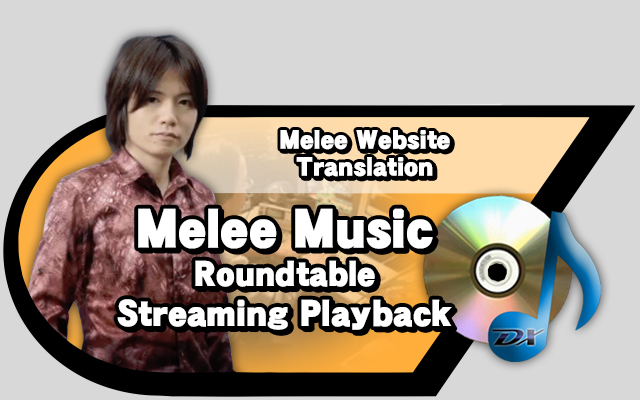This is post 7 (of 8) translating the roundtable discussion about Melee’s sound and music, found on the Japanese Melee website. This is a short one where Ikegami talks about the technology behind the game’s seamless music playback. Enjoy!
Streaming Playback
Sakurai: Any words about streaming playback?
Streaming playback: Streaming recorded data exactly as is. If things like data compression and loading are involved, it gets more complicated.
Ikegami: Right, let’s see. The term “streaming” is a little inaccurate. This story might get technical, but for this project we called for some things that were pretty unreasonable. However, Research and Development worked hard and came through for us.
Research and Development: HAL Labs’ internal division that develops the technology used in their games
At first we were using the “hardware stream” technique, but with that, there wasn’t enough space on the GameCube disc for everything Mr. Sakurai wanted to include.
Hardware stream: A playback method that works roughly the same way as a CD. Song data is stored in its entirety, then gets played back as is.
Thus, midway through development, the idea of “program streaming” came about, a technique that could work with little space.
Program streaming: A technique where the music gets stored as data in memory, then gets played back as it is read, little by little.
That was around September of 2001, when I asked the R&D staff for help. They said, “Somehow, we’ll make it happen,” and they were able to put it together.
Ando: Wonderful.
Ikegami: It sure was. That’s why we were able to make the background music stream in a loop, and furthermore, fit everything into such a small capacity.
Sakai: Well, the point where the song loops isn’t obvious at all. In a question sent in for the Smash Bros Dojo, someone even asked, “Does this game use software instruments**?”
TN** The term 内蔵音源 literally translates to ‘internal sound source,’ but this most likely refers to using MIDI tracks and synthesized instruments to generate the music on the fly, as opposed to streaming recorded music.
Ikegami: Since no matter how long the song plays, it doesn’t fade out. It’s streaming, but it loops. Because of that, I told Mr. Sakurai, “This technique is something to brag about, huh?” but he said, “Well, if you think you can brag about it, this is already being done elsewhere,” and I felt a bit disappointed (laughs).
Sakurai: Sorry, but with a technical matter like that, it’s often the case that it’s already being used somewhere else.
Ikegami: But, if that technique hadn’t been developed, we wouldn’t have been able to include the special movie, and we would have had to cut the songs off somewhere.
We wouldn’t have been able to include the special movie: The Smash Bros. disc was already close to maximum capacity.
Sakurai: I’m glad it didn’t come to that!
There’s one more part in this series on the way, so please look forward to it!
- Straight from the Source: Shuto Mikami (RUINSMAGUS: COMPLETE) - October 19, 2023
- Straight from the Source: sewohayami (100animalease) - October 17, 2023
- Straight from the Source: Kotaro Dendaira (Aojuji Hospital: Tokyo Eidolic Anatomy Division) - October 10, 2023








